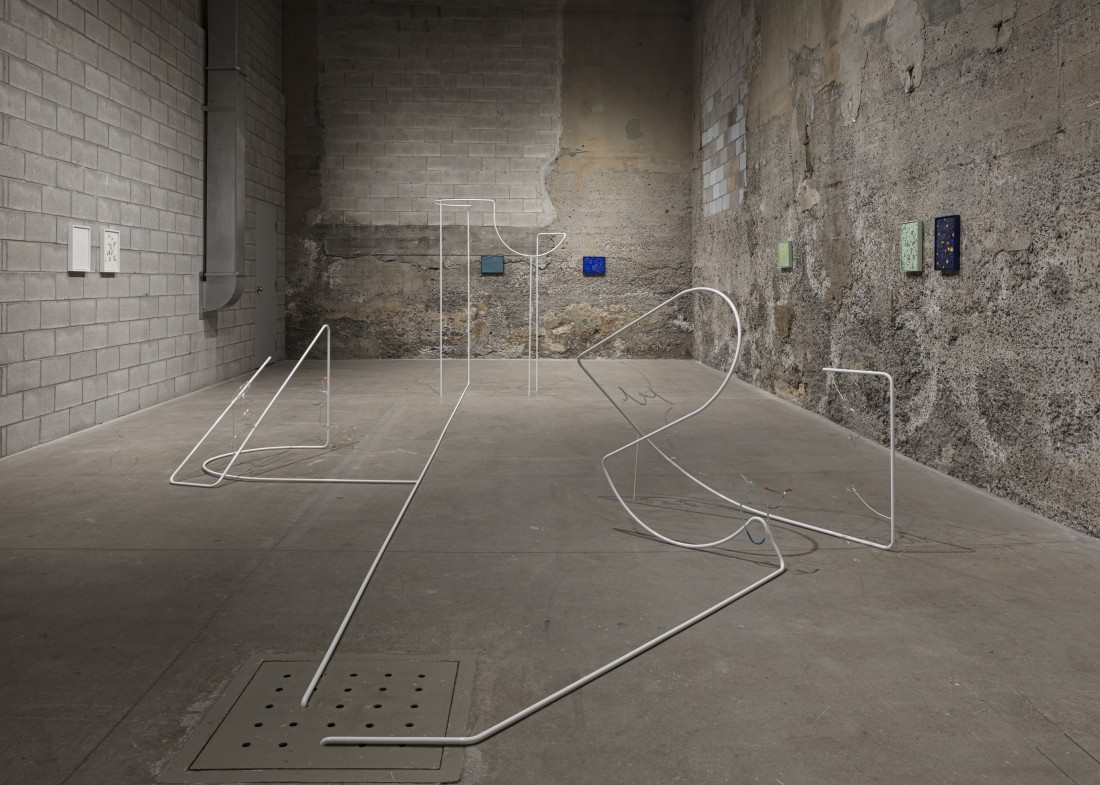Marie-Michelle Deschamps
Out of the central drainage of the gallery’s bunker space emerges the main component of “Oasis,” Marie-Michelle Deschamps’s latest exhibition at Bradley Ertaskiran. Failed Ink / Une encre qui n’a pas tenu sa promesse is a large installation composed of white steel wires that trace swirling lines across the space of the gallery, all the while offering a support structure for airy glass tubes filled with coloured enamel powder that seem to dangle precariously at various points. The large sculpture casts serpentine shadows on the concrete floor of the gallery, suddenly activated by the comings and goings of the gallery- goers. This exhibition’s umbilicus is also circled by 11 small wall pieces that highlight colourful slabs in the otherwise dreary architecture of the subterranean room.
This new body of work created during the COVID-19 pandemic takes inspiration from the Voynich Manuscript, a mysterious codex suspected to be a cryptic pharmacopeia dating back to the 15th century and filled with botanical illustrations and illegible inscriptions written in a cipher yet to be decoded. Like the manuscript, Deschamps’s work is also grounded in a conflicted desire to conceal and disclose. Her work draws from botanical observations but quickly departs from representation, as if the artist was lost in reverie. The artist privileges a mode of communication that isn’t spelling out a message but is letting it be perceived instead. Chimera and contemplation are ever-present through this new body of work. In front of her obfuscated message, the viewer is left to enjoy the harmony of textures, shapes and colours with unknowing delight.

Marie-Michelle Deschamps, installation view, “Oasis,” 2021, Bradley Ertaskiran, Montreal. Photo: Maxime Brouillet.
Because of the premise of the Voynich Manuscript, it’s perhaps not surprising that many of the pieces in the exhibition refer to the realm of language and to the practice of writing. This is achieved through Deschamps’s choice of materials in the case of the graphite-on-paper works but also through titles such as Alphabet, Charade, or Coquilles. The wall works either refer to the complex language of botany (Parasols #1, Parasols #2, Astrancias or Chrysantème), or present elegant, playful squiggles (Larmes, sans-titre). Even the principal structure described above, Failed Ink, is reminiscent of writing. Its curls and arcs echo the manuscript’s sophisticated yet enigmatic scribbles. This is not the first time that coded language informs Deschamps’s artistic practice. For “Je relis les lignes,” her two-person show at Diagonal in Montreal in 2017, it was the Microscripts of the Swiss writer Robert Walser that were the departure points of her collaborative project with the French artist Éléonore False.

Marie-Michelle Deschamps, installation view, “Oasis,” 2021, Bradley Ertaskiran, Montreal. Photo: Maxime Brouillet.
What is new with this body of work, however, is a dabbling with colour that has not previously been seen in her practice. Using mineral powders, copper, glass and silver that she combined to her enamel pieces, Deschamps left it up to chemistry and physics to congeal the materials and ultimately determine the final appearance of the work. By relying on the fateful science of the materials she favoured, coupled with her reference to an ancient pharmacopeia, the artist reminds us that before covering the ground with thick asphalt, before ascending into increasingly tall buildings, we used to dirty our hands and feet in the ground as an auspicious ritual of cultivation.
Marie-Michelle Deschamps’s colourful speckled surfaces convey the richness of the amalgam of organic materials—minerals and metals predominantly— used in her production process. The heterogeneity of materials in her practice contextualizes the existence of things existing alongside, within and through other things, as a propitious fertile soil. In this way, her work mirrors an abundant garden. What she constructed is a protected area of contemplation, play and encounter. The promise of “Oasis,” as suggested by its title, is the conviction that even in a hostile and barren space like a bunker, a garden can emerge. ❚
“Oasis” was exhibited at Bradley Ertaskiran, Montreal, from February 11 to March 13, 2021.
Anaïs Castro is a curator and writer based in Toronto and New York. She has curated exhibitions and projects in Canada, the United States, across Europe and in China, and writes regularly for various art magazines.

